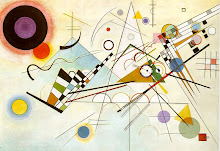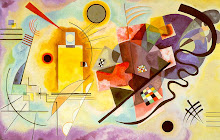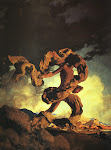Convergence
1952
Jackson Pollock is someone I've wanted to re-feature for a while (the first post was a bit austere). He remains an extremely controversial artist, whose critics and fans seem equally zealous in their arguments. And, while we know Pollock mostly for his sort of Abstract Expressionist works (a sub-style often labeled Action Painting or Gestural Abstraction), such as the piece above, he also worked for a long time in Expressionism, largely influenced by Picasso. Lastly, I want to note that his particular style of Abstract Expressionism is very strongly indebted to Kandinsky, but, for some reason, the derivation is barely ever stressed. What do you think of Pollack?
Head
1940-1941
Male and Female
1942
Composition with Pouring II
1943
Naked Man with Knife
1938-1940
Blue Poles: Number 11, 1952
1952
Woman
1930-1933
Number 14, 1951
1951















i love pollack!
ReplyDeleteseeing blue poles at the canberra gallery has been a transcendental experience every time
true genius!!!
x, thank you for sharing your experience. Transcendental moments are the ones that matter most in any art, I think.
ReplyDeleteI've always really enjoyed Pollack but must admit that I'd only ever seen his works that are like Convergence and wasn't aware of his work in other styles.
ReplyDeletePerhaps some of his critics say that to paint something like Convergence is easy, that it requires less technical expertise than other more realistic modes...? Well, I'm not so sure that this is easier but even granting that it is, ultimately isn't it about the end product? The ability of works to create things like, as x says above 'transcendental experiences' ?
r-h s, some critics certainly say that. But there are other arguments, such as that not everything transcendent is art (i.e., people one's attracted to, structures in nature, animals, space etc.). Others say that it simply doesn't fit into the definition of what art is (and the definitions vary greatly). Still, if art is what is beautiful, perhaps St. Aquinas was right in saying that "We call a thing beautiful that pleases the eye;" therefore anything pleasing is art. But it's a difficult and convoluted topic, so I'm not sure of the conclusion.
ReplyDeleteI, too, like Pollack. I do think you have to see his paintings in person to truly appreciate them & the experience. It is easy enough to see why his critics find fault with such a technique. I guess, the final say, must ultimately, rest in the eye of the beholder.
ReplyDeleteI most enjoyed seeing so many nice examples of his early work. Especially Composition with Pouring II 1943. Thanks again for sharing your expertise & knowledge of art history. I always find it interesting.
Sally, that's a very good point. All the artworks I've displayed were created to be viewed in person, and the experience of staring at them in the flesh rather than through a monitor is fathoms different. Thank you for the comment.
ReplyDeletesomething beautiful only becomes art once it is transformative, if it transcends its physical limitations. I love how pollock still looks fresh at times. Much of his work prefigured 80s neo expressionism, and much of his early drawings and notebooks prefigured the current (since 90s) fascination w teenage / youth angst. that convergence is extremely beautiful thank you 4 posting.
ReplyDeleteSven, thank you for your insight. Certainly art could be beauty transformed, but then how do we define transformation? Does it have to be conscious? Does it have to be methodical? And another question would be, is such a thing such as transcendence possible? Perhaps, as Wilde said, art is a sort of useless beauty. If the latter's the case, art doesn't have to transcend, but rather has to tend towards a mundane apathy. Any way you slice it, I'm not certain of what art is yet.
ReplyDeleteAs for Pollock's influence, it certainly has been notable. But, I wouldn't necessarily credit him for prescience relative to the contemporary movements that focus on teenage angst. His early period was, in my opinion, too strongly derived from Picasso, specifically, and the New Objectivitist and Futurists movements, broadly, to be considered an original spark in those modern movements. I'd say the bigger influence has been Warhol and the Dadaist and Neo-Dadaist movements. But we could be thinking of different artists.